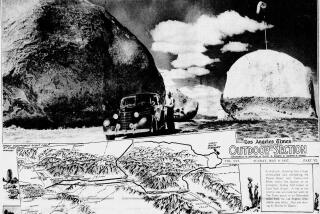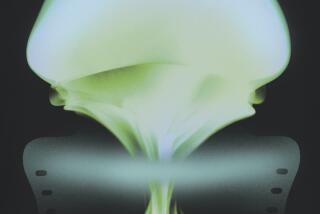Life as Satanist Propelled Rocketeer
- Share via
I height [sic] Don Quixote, I live on peyote,
marijuana, morphine and cocaine.
I never knew sadness, but only a madness that
burns at the heart and the brain.
--John Whiteside Parsons
*
He was an unorthodox genius, a poet and rocket scientist who helped give birth to an institution that would become mankind’s window on the universe.
He was also a devotee of the black arts, a sci-fi junkie and host of backyard orgies on Pasadena’s stately Millionaires’ Row.
John “Jack” Whiteside Parsons, a founder of the legendary Jet Propulsion Laboratory and a maverick visionary honored with a moon crater bearing his name, gave no early hint of the inner stirrings that propelled him to worship the devil and lead an extraordinary double life: respected scientist by day, dedicated occultist by night.
Over a little more than a decade, the tall and vainly handsome Parsons skillfully twinned his two existences as rocketeer and antichrist leader of the occult Ordo Templi Orientis.
His mysterious death in an explosion in 1952 left many wondering whether Parsons was a victim of murder or suicide--or simply of an accident at his own momentarily careless hands.
Born Marvel Whiteside Parsons in 1914, he was a mama’s boy who hated authority and detested social mores. He was reared by his aging, wealthy grandparents and his mother, Ruth. Embittered by her adulterous husband, also named Marvel, who abandoned his family, Ruth began calling her son John.
Young John found his companions in poetry, which he read the way other boys read comic books. He also gulped down the space and sci-fi fantasies of Jules Verne. He and his childhood pal, the mechanically gifted Ed Forman, tinkered with black-powder rockets and pocked their backyards with craters.
Parsons was at USC when word of Caltech graduate student Frank Malina’s project on rocket propulsion and high-altitude rockets reached him and Forman. The young duo brazenly offered to help. Even though neither youth had a degree, Theodore von Karman, the director of Caltech’s Guggenheim Aeronautical Laboratory and one of the world’s leading scientists, took them up on their offer.
Unencumbered by academic knowledge, Parsons was a cookbook chemist obsessed with things that go bang, while Forman helped turn designs into hardware. On Halloween 1936, the rocketeers dug trenches and piled up sandbags in the Arroyo Seco and attempted to test a rocket motor they had built. Fueled with a brew of gaseous oxygen and methyl alcohol, the motor burned for three seconds.
This inauspicious beginning marked the start of rocketry in California at a time when America still saw space exploration as pulp fiction. The test site in the Arroyo Seco later became JPL.
Von Karman allocated campus lab space to the rocketry project. But after two lab explosions, the group--by then dubbed the “Suicide Squad”--was kicked off campus and headed back to the Arroyo Seco.
Parsons’ new fame as Caltech’s best explosives expert took him to the courtroom as an expert witness. In 1938, he testified against Los Angeles Police Department Lt. Earl Kynette, a mayoral crony accused in the car bombing of an ex-LAPD detective-turned-private eye.
Parsons earned his bread and butter working on a jet-assisted takeoff unit that developed into a solid-fuel rocket that would help win World War II.
Early in the war, in 1942, Parsons and his wife, Helen, moved into an aging Pasadena mansion. The house on South Orange Grove Boulevard was next door to the former estate of beer baron Adolphus Busch with its famous gardens.
But Millionaires’ Row had never seen anything like Parsons and his friends.
Parsons converted the rooms into 19 apartments, and invited in an odd mix of Bohemian artists, writers, scientists and occultists. The residents mockingly named the place “the Parsonage,” for it was anything but.
Before dropping out of USC, the poetry-loving Parsons had cultivated an interest in the writings of Aleister Crowley, the English sorcerer and Satanist who called himself “Beast 666” and “the wickedest man in the world.”
Soon the house on South Orange Grove was a laboratory of another sort--for black magic.
In 1944, Parsons resigned from JPL in favor of whizzing through time and space via peyote, mescaline, marijuana, opiates and hallucinogens.
Soon, the marriage began to unravel. Helen became pregnant by another member of the Parsonage circle, and Parsons took up with Helen’s beautiful 18-year-old sister, Sara Northrup, before divorcing Helen.
Mutual curiosity about the mind’s power led Parsons into a friendship in 1946 with L. Ron Hubbard, the future founder of Scientology. Hubbard moved into the house and later married Sara, Parsons’ lover and sister-in-law, before divorcing his first wife.
According to “Sex and Rockets: The Occult World of Jack Parsons,” a new book by John Carter (a pseudonym), Hubbard chanted incantations while Parsons and his new lover, Marjorie Cameron, tried to produce a “moon child,” a “magical child” with superior intellect and powers whose birth would occur on the astral plane, not the physical one.
The ceremony was to span 12 consecutive nights. But when rituals called for a naked pregnant woman to jump nine times through fire to ensure a safe delivery, the neighbors began protesting. The police looked into the matter, but nothing came of their investigation.
Parsons and Hubbard, who had united to take on Christianity, fell out over more trivial matters. Carter writes that the two argued over a sailboat venture that ended in a court dispute.
Disillusioned with Hubbard, Parsons resigned from the Ordo Templi Orientis, married Cameron and began exploring the unknown on his own. After one reputed out-of-body experience, he acquired the name “Belarion Armiluss Al Dajjal, antichrist.”
But even the antichrist had to eat. Low on funds, he worked for various local aviation companies, including Hughes Aircraft, and bootlegged nitroglycerin.
It was after he left the mansion and moved with his wife into a rented room over the garage at the Cruikshank Estate on South Orange Grove that life began to unravel.
The FBI was investigating him on suspicion of espionage, consorting with communists, including some allegedly at Caltech, and cult activities; the scrutiny cost Parsons his government security clearance.
In June 1952, while his wife shopped for groceries for a planned vacation to Mexico, Parsons mixed chemicals from his arsenal of illegal explosives.
Police reports say the explosives expert dropped the concoction of fulminate of mercury. A deadly blast that could be felt a mile away ripped through Parsons’ garage lab, blowing off his right arm, breaking his other arm and both legs, and leaving a gaping hole in his jaw.
He died 45 minutes later. When his mother heard the news, she joined him in death, gulping down a bottle of sleeping pills.
Authorities concluded that his death was a drug-induced accident or suicide. His wife and others believed he was killed by the recently paroled Kynette, whom Parsons had helped put in prison.
To this day, there’s a joke in the aerospace community that JPL stands for “Jack Parsons’ Laboratory” or “Jack Parsons Lives.” The Crater Parsons, named in his honor, happens to be on the moon’s dark side.
More to Read
Sign up for Essential California
The most important California stories and recommendations in your inbox every morning.
You may occasionally receive promotional content from the Los Angeles Times.










